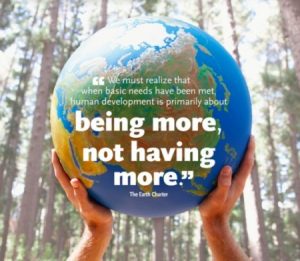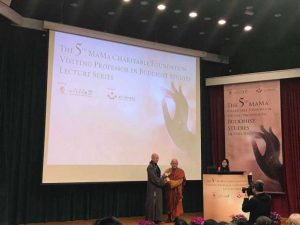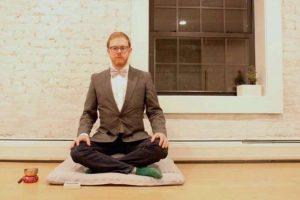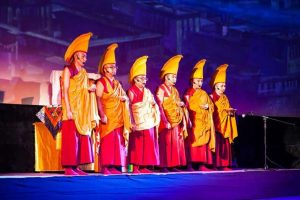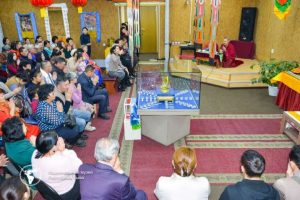There is no Buddha in the mountains
At a quiet late-night hour in the summer of 1236 CE, the Year of the Monkey, when the palace guards were few and drowsy, Trần Thái Tông, the king of Đại Việt, modern day Vietnam, pulled a cloak up over his shoulders, covered his face with a cloth, and saddled a horse to ride off into the wilderness. He had been coronated at the age of eight, burdened all too soon with the responsibility of leading a whole nation and defending it from the growing threat of the Mongols consolidating power to the north. Now 16, he wanted to be unchained from worldly concerns, to retreat into the mountains and study the Dharma. The king found his way to Yên Tử Mountain and, climbing to its summit, encountered the forest abode of Zen Master Trúc Lâm.
This is a pivotal moment in the history of Thiền, the Vietnamese transmission of Zen. Sixty years from this moment, Trần Thái Tông’s descendant would establish the first indigenous Thiền school on that spot, named for the master that the emperor met there that night: Trúc Lâm. The story of the Trần dynasty being a Buddhist golden age in Vietnam begins here, with King Trần Thái Tông yearning for the bamboo forest, stealing off into the night to beg Master Trúc Lâm for ordination. King Trần Thái Tông came to the mountain abode and pleaded for the master to accept him. He said:
“I was only a child when I lost both of my parents, left in this lofty position above the people without guidance or support. I was reflecting back on the careers of the previous [Việt] kings, the impermanence in the rise and fall [of their reigns], and so I came to this mountain seeking only to become a buddha, not to ask for anything else.” (Thích Thanh Từ, 16)
Master Trúc Lâm responded:
“There is no Buddha in the mountains, the Buddha is found only in the mind. What is called the True Buddha is [just] a mind pervaded with quietude and insight. If Your Majesty can awaken to this mind, he will immediately become assured of his buddhahood—there will be no need to bother seeking it outside.” (Thích Thanh Từ, 16)
And so the Master Trúc Lâm sent the king on his way, back to the palace and the responsibilities of ruling the realm. King Trần Thái Tông would go on to rule for 22 more years, fighting back an attempted Mongol invasion in the process, all the while committing himself to the practice of meditation and scriptural study, authoring several commentaries. At the age of 40, he abdicated the throne, shaved his head and donned the yellow robe, retiring himself to Yên Tử Mountain where he composed what is considered his most significant work: Essays on Emptiness (Vn: Khóa Hư Lục), a Zen meditation manual largely unknown to Western audiences, comprised of short commentarial essays on a variety of topics ranging from bodily posture and meditation technique, to the generation of bodhicitta, discussion on the precepts and repentance practice, and instruction on embodying the prajnaparamita in action.
Threading through each essay is the role its titular topic plays in working toward insight into emptiness and liberation from suffering. Each essay is brief, but methodical and demonstrates Master Trần Thái Tông’s erudition and scholarship in the Zen tradition. But what might be most striking to find in a medieval Zen text like this, especially for a Western audience, is the “Treatise on Buddha-mindfulness” (Vn: Luận Về Niệm Phật). While the Pure Land-Zen Dual Cultivation (Vn: Thiền Tịnh song tu) tradition is arguably the most widespread and popular form of practice in mainland East Asia, it has received little attention in the West. There is often a perception for those who are even aware of the tradition’s existence that it is the result of a pre-modern syncretism between “historically pure” and sectarian Chan and Pure Land schools, but more recent scholarship has shown that this dual practice tradition has much deeper roots, stretching back to the very origins of the Chan tradition itself.

Pure Land-Zen dual practice in Chinese and Vietnamese history
Outside of the Japanese traditions that, for historical reasons, delineated the separate schools of Mahayana Buddhism with distinctive sectarian borders, resulting in the Zen and Pure Land schools diverging, this separation has never been the case on the mainland. According to scholar Sam van Schaik, the earliest Chan meditation manual we have from Dunhuang opens with instructions on the practice of Buddha-recitation. (van Schaik) This would place Buddha-recitation as a central Chan practice as soon as the Chan school emerged in any distinguishable form. And King Trần Thái Tông’s “Treatise on Buddha-mindfulness” chapter from Essays on Emptiness is a remarkable testament to how the tradition of Pure Land cultivation within a Zen context, having originated with the early Chan schools in China, was transmitted to and lived on in the practice and culture of 13th century medieval Vietnamese Buddhism. The text’s significance to the living practice of Vietnamese Buddhists today also becomes readily apparent, as the historical scope unfurls for simultaneous Pure Land-Zen practice being a signatory characteristic of Vietnamese Buddhist tradition spanning back nearly a thousand years.
The Zen practice of reciting the Buddha’s name
Zen Master Trần Thái Tông opens the “Treatise on Buddha-mindulness” by declaring:
All Buddha-contemplation practice arises from the mind. When the mind is wholesome, then wholesome thoughts arise; when wholesome thoughts arise, then wholesome karma is cultivated. An unwholesome mind results from unwholesome mental states, giving birth to unwholesome karmic actions, and then to rotten karmic fruit. Like a reflection in a mirror, [the mind] reflects a simulacrum. And so Chan Master Yongjia said: “One without thought is one without birth” with this meaning. (Thích Thanh Từ, pp. 230)
Master Trần Thái Tông explains how the efficacy of Buddha-recitation contemplative practices begins with the purification of karmic tendencies. By focusing the mind on the Buddha’s name and form, wholesome states of mind naturally follow. It is this process that facilitates Buddha-contemplation’s tremendous power to purify karma. Buddha-recitation is a complete practice in and of itself, one which causes the three kinds of karma—action, speech, and mind—to immediately cease. The master elaborates further,
Why is it the three karmas are brought to cessation through Buddha-mindfulness? Because when visualizing the Buddha’s body, [an adept is] sitting upright, refraining from unwholesome conduct—[this] ceases the karma of the body. The mouth is engaged with chanting dharanis—refraining from unwholesome words ceases the karma of speech. The intention to strive diligently, refraining from unwholesome thoughts is the cessation of the karma of the mind. (Thích Thanh Từ, pp. 230)
Having brought the three kinds of karma to cessation, a dual cultivation adept must then continue to cultivate through Buddha-recitation until body, speech and mind are completely unified in the practice. The master encourages practitioners to “diligently recite the Buddha’s name with their mouth, desiring to see the Buddha’s image in their mind, and vow for their bodies to be reborn in that buddha-land. Cultivators must practice diligently day and night, without turning back.” (Thích Thanh Từ, pp. 231) When this practice is refined to the second stage, Master Trần Thái Tông writes, “The mantras are held constantly in one’s thoughts,” and the practitioner reaches a state where they “never lose their mindfulness, having imbued the mind with purity.” At the highest stage, the practitioner will “have attained mindfulness that is perfected, honed to a single point.” (Thích Thanh Từ, pp. 231)
This practice, and the exegetical explanation for its efficacy as described in Essays on Emptiness, is virtually left unchanged today in the living Vietnamese Buddhist tradition. Writing on the contemporary meditative practices of Chùa Hoằng Pháp in Ho Chi Minh City, Venerable Thích Tâm Thức describes and elaborates on a name-recitation contemplative practice largely identical to that described by King Trần Thái Tông:
After the moving on from the beginning practices of reciting with a mala or counting, practitioners chant with total mindfulness that is meant to completely focus body, speech and mind on the Buddha’s name until one-pointedness of mind (cittekaggatā) is achieved. . . . Any technique of practice within the Pure Land tradition is based on Amitābha Buddha’s power to assist with achieving enlightenment through the synchronicity of the practitioner’s karma of body, speech and mind. . . . If the average practitioner is not able to move beyond the samatha stage, they will not be able to go further onto the cultivation of one-pointedness of mind (cittekaggatā). (Phan Tai Thuc)
Here we see that the use of Buddha-mindfulness as a meditative technique to cultivate tranquility of mind and establish samadhi, and explaining this practice’s efficacy through the attenuation of the three kinds of karma, remains a living practice in Vietnamese Buddhism today.
Realizing your mind is the Buddha’s mind
Central to all Zen traditions is that the practice leads to a direct confrontation with one’s own buddha-nature, which consequently leads to the realization of non-duality. The dual practice traditions are no exception to this, while simultaneously holding the aims characteristic of Pure Land practitioners as well (i.e. the aspiration to achieve synchronous resonance with Amitabha Buddha—often signified by a visionary experience or the attainment of samadhi—and the aspiration to be reborn in Amitabha’s Pure Land, as mentioned in the previous sections). Master Trần Thái Tông, writing on the pinnacle of mastery within Buddha-recitation Zen practice, says:
[Those practitioners] at the highest level of wisdom have realized the mind itself is the Buddha and that there is nothing left to cultivate. They abide in a state of pure mindfulness, a state thus called immovable, which is the same as the Buddha’s body. [They realize] the Buddha’s body is the same as their own body, they do not appear separately. They see that appearances have no delineation; all that appears, appears tranquil and still, moving without action, emptied of thought—right there, suddenly, they become living Buddhas. (Thích Thanh Từ, pp. 231)
The famous contemporary Vietnamese Zen Master Thích Thanh Từ explains this passage in the commentary to his translation of Essays on Emptiness by saying:
Here, [Trần Thái Tông] gives us a way to see that the Dharmakaya of the Buddhas is within ourselves. Any moment of quietude is a moment where one is living in attunement with the Buddha’s Dharma-body, which is always present, which has never been hidden, and which is called the supreme wisdom. If you recite the Buddha’s name with this understanding, then the two paths of Zen and Pure Land cannot be differentiated. (Thích Thanh Từ, pp. 101–02)
While often regarded as two separate traditions, Ven. Thích Thanh Từ here makes the case that Zen and Pure Land cannot be easily differentiated from one another—they are merely different pedagogical tools for achieving the same realization: complete buddhahood.
Zen is Pure Land, Pure Land is Zen
In Vietnamese monasteries and temples all over the world, lay and monastic practitioners gather together to diligently recite Amitabha Buddha’s name over and over, vowing to be reborn in that buddha-land, aspiring to receive a mystical visionary experience of the Buddha through their practice. Despite not resembling the kind of Zen practice that has become most familiar to Western audiences, these communities still claim to be thoroughly enmeshed in the tradition, institution, and culture of the Chan-Zen framework emphasizing sudden awakening and a direct confrontation with buddha-nature.
The Vietnamese Buddhist tradition has for centuries seen Pure Land and Zen teachings and practice to be complementary non-exclusive paths toward the realization of buddhahood. King Trần Thái Tông’s masterful Essays on Emptiness thus is a significant Vietnamese contribution to the Zen literary landscape, not just for its succinct instructions on more familiar Zen teachings, but especially for showcasing the deep history of Pure Land-Zen simultaneous cultivation in East Asia. The text being largely unknown outside of Vietnam is a great disservice to the greater Buddhist world, as Essays on Emptiness is truly a remarkable testament to the ancient tradition of marrying together Zen and Pure Land teachings into a cohesive model of dual cultivation, one that continues to be one of the most popular forms of Buddhism practiced today in Vietnam and among the Vietnamese diaspora.
An Tran is a writer from Alexandria, Virginia, and a lay practitioner of the Vietnamese Pure Land-Zen Dual Cultivation tradition. He is the author of the short story collection, Meditations on the Mother Tongue. His writing has appeared or is forthcoming in Lion’s Roar, LitHub, Southern Humanities Review, The Carolina Quarterly, Gargoyle Magazine, and many others. He has won a “Distinguished Work” recognition from Best American Essays, “Notable Work” recognition from Best American Short Stories, and nomination for the Pushcart Prize. He currently lives in San Francisco.
References
Phan Tai Thuc (Ven. Thích Tâm Thức). “The Practical Method of Pure Land Buddhism in Modern Society of the Hoang Phap Monastery in Vietnam.” Maha Chulalongkorn Rajavidyalaya University. Bangkok, Thailand; 8 March 2018.
Thích Thanh Từ. 1996. Khóa Hư Lục Giảng Giải (Commentary on Essays on Emptiness). Thiền viện Thường Chiếu (Thuong Chieu Zen Monastery); Long Thành, Việt Nam.
van Schaik, Sam. “Meditation Practices in Tibetan and Chinese Chan Manuscripts from Dunhuang”, How Zen Became Chan Conference. 31 July 2022.
Related features from BDG
Thich Minh Tue: A Therapist for a Wounded Society
Buddhistdoor View: Mending Old Wounds – US and Vietnam Seek Friendship in a Complex World
Monastics in White: The Medical Monks and Nuns of Vietnam
Reviving a Vietnamese Family Tradition – The Trantien Foundation





